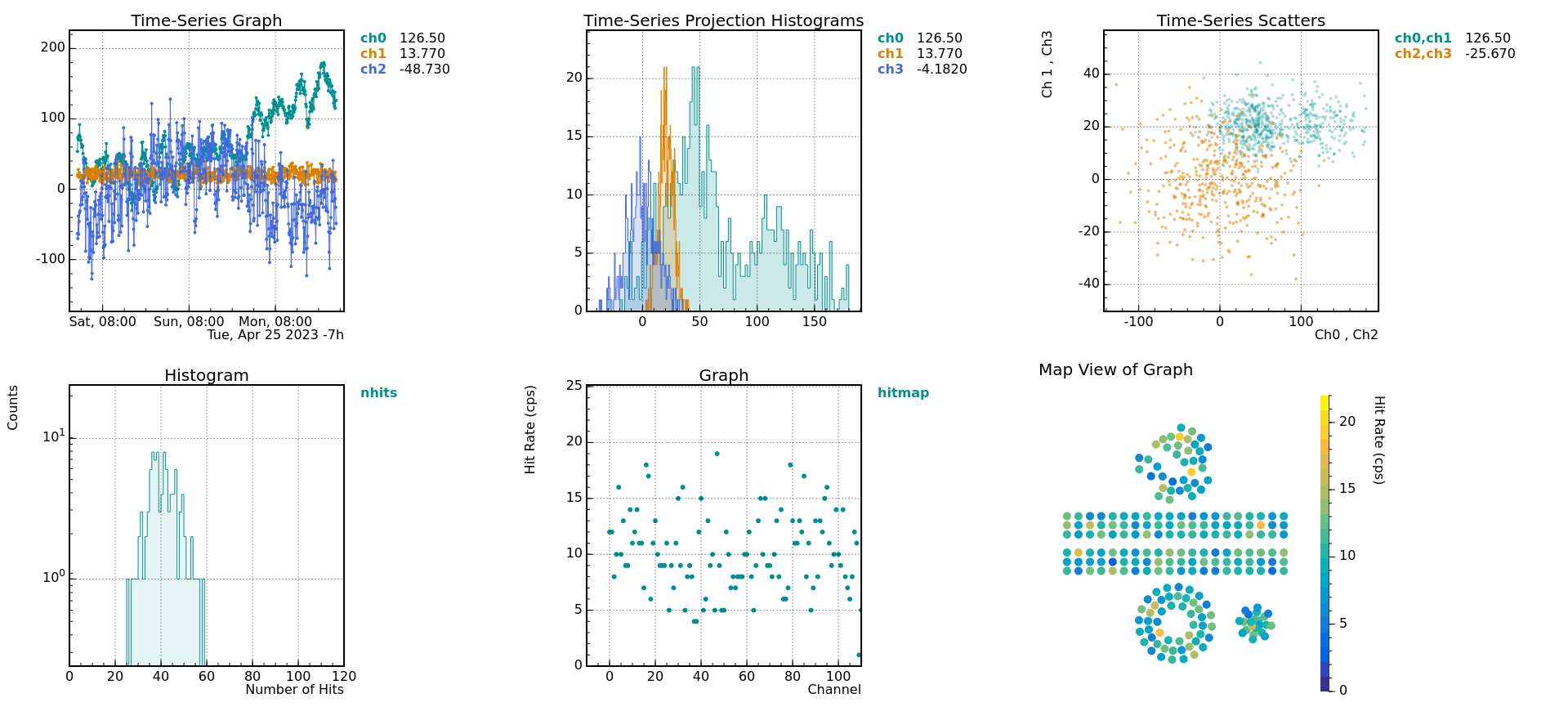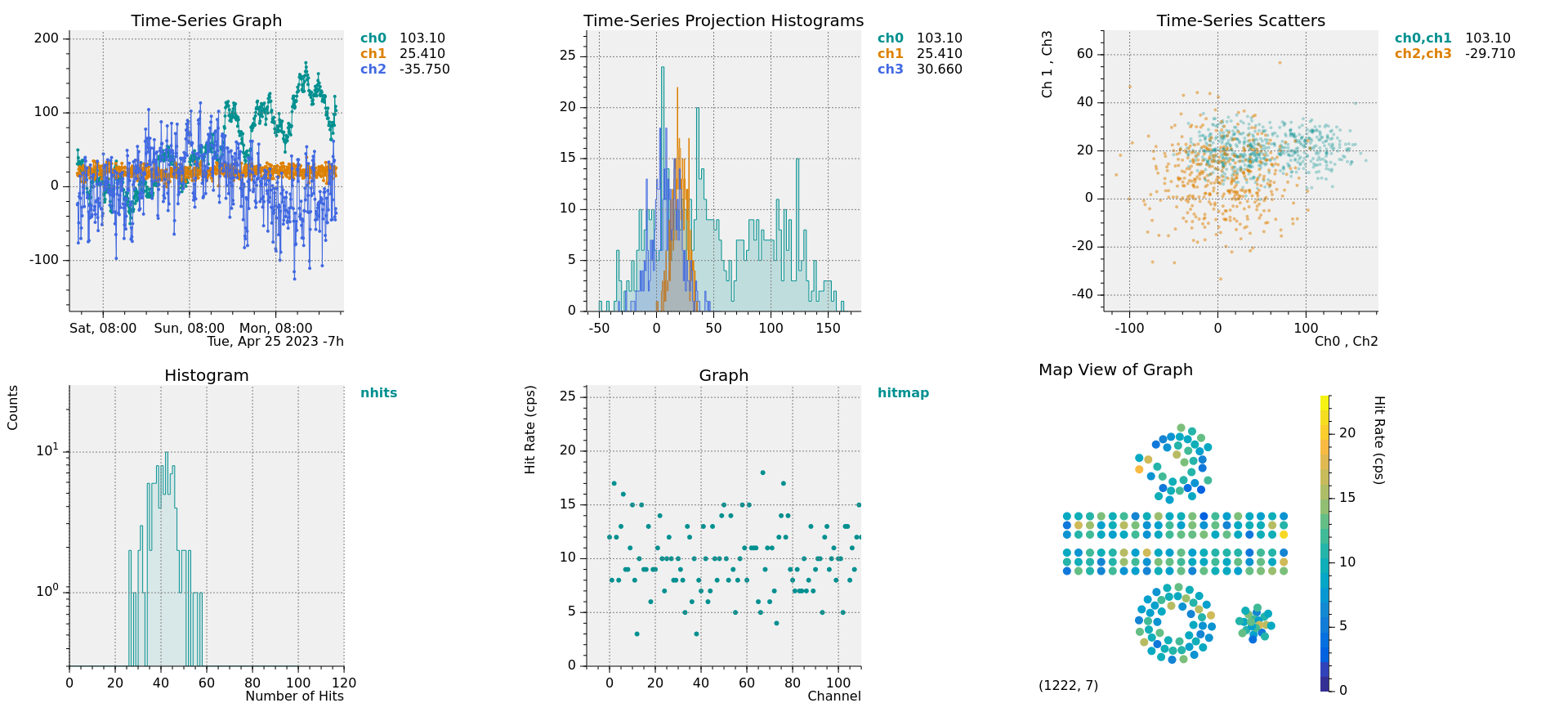
Every project has a dedicated project directory.
Configuration file is SlowdashProject.yaml, placed at the project directory.
Project directory is specified at run time by one of the followings:
--project-dir optionSLOWDASH_PROJECT environmental variableUnder the project directory, config directory is automatically created. Web interface posts files only to this directory.
Project configuration file describes:
Example:
slowdash_project:
name: ATDS
title: Atomic Tritium Demonstrator at UW (ATDS)
data_source:
type: PostgreSQL
parameters:
url: p8_db_user:****@localhost:5432/p8_sc_db
time_series:
schema: data_table[channel]@timestamp=value
style:
theme: light
title:
color: white
background: "#4b2e83"
system:
file_mode: 0666data_source, often necessary)type: type of user data store. Common ones are:
PostgreSQL, MySQL, SQLiteInfluxDBRedisMongoDBCouchDBYAMLparameters: defined by each data source. See the Data Binding section for details.module, optional)style, optional)See Styles below.
system, optional)file_mode (default ’0644`): Access mode of configuration files uploaded from Web clientsfile_gid: Group ID of configuration files uploaded from Web clientsauthenticate, for special purposes)See Security Considerations below.
theme (default light): currently light or darktitle:
color: title text color (default white)background: title bar background (default #4b2e83)logo:
file: file name of the logo image, stored under the project config directory.position: left or rightbackground: background color (default none)link: URL to open when the logo is clickedpanel:
plotGridEnabled, plotTicksOutwards: true or falseplotBackgroundColor, plotMarginColor, plotFrameColor, plotLabelColor, plotGridColorplotFrameThickness: default 2negate: list of image files used in canvas, the colors of which are to be negated (for dark mode) style:
title:
background: linear-gradient(125deg, rgba(75,46,131,1), rgba(75,46,131,1), rgba(75,46,131,0.9))
logo:
file: P8_Logo_2017.png
position: left
background: linear-gradient(90deg, rgba(255,255,255, 0.6), rgba(255,255,255, 0.4), rgba(255,255,255, 0))
The background property takes CSS “background” values / expressions. See, e.g., a Mozilla document for some examples.
The logo file(s) must be placed under the project config directory.

style:
theme: dark
style:
panel:
plotTicksOutwards: true
plotFrameThickness: 0
plotBackgroundColor: "#f0f0f0"
plotGridColor: gray
Running the slowdash command without the --port option takes parameters from the arguments and prints output to screen. Run the command at the same directory as the configuration file is located.
$ slowdash config
{
"project": {
"name": "ATDS",
"title": "Atomic Tritium Demonstrator at UW (ATDS)",
"error_message": ""
},
...
}$ slowdash channels
23-03-22 12:48:34 INFO: loaded datasource module "datasource_SQLAlchemy"
[
{"name": "sccm_Alicat_Inj_Gas"},
{"name": "mbar_CC10_Inj_Gas"},
{"name": "mbar_IG_Vac_MS"},
{"name": "degC_RTD1_Acc_AS"},
{"name": "degC_RTD2_Acc_AS"},
...$ slowdash 'data/sccm_Alicat_Inj_Gas?length=60'
23-03-22 12:50:20 INFO: loaded datasource module "datasource_SQLAlchemy"
{
"sccm_Alicat_Inj_Gas": {
"start": 1679514341, "length": 60,
"t": [2.364, 12.364, 22.355, 32.366, 42.364, 52.362],
"x": [-0.015, -0.014, -0.014, -0.015, -0.014, -0.016]
}
}When the argument includes a special character of the shell (such as ? and &), quote the entire argument.
WARNING: Slow-Dash is designed for internal use within a secured network and therefore no security protection is implemented. It is strongly recommended not to expose the system to the public internet. External access is assumed to be done through VPN or ssh tunnel.
$ slowdash --project-dir=PROJECT_DIR --port=18881--project-dir can be omitted if:
SLOWDASH_PROJECT environment variable is set, orslowdash command is launched at the project directory.
slowdash process must keep running while accepting the Web requests. For this, a terminal multiplexer, such as “tumx” or “GNU Screen” would be useful.[TODO]
Slowdash can be executed as CGI of a web server such as Apache or Nginx. To setup this, run the script below at the project directory:
$ slowdash-setup-web
Project: ATDS
Project directory: /home/sanshiro/Project8/SlowDash/Projects/ATDS
Web-file directory: /home/sanshiro/public_html/SlowDash/ATDS
continue? [Y/n] y
Web-file directory created: /home/sanshiro/public_html/SlowDash/ATDS
=== INSTALLATION IS SUCCESSFUL ===
*) To setup SLOWDASH Web for another project, set SLOWDASH_PROJECT and run this program.
*) It is safe to run this slowdash-setup-web multiple times, even for the same project.
*) Web interface can be disabled by deleting the web-file directory.
*) Disabled Web interface can be re-enabled by running this program again.
*) Web-file directory for this project: /home/sanshiro/public_html/SlowDash/ATDSThe script will copy all the necessary files under user’s web directory (typically /home/USER/public_html) and create .htaccess with the contents below:
DirectoryIndex home.html
Options +ExecCGI
AddType application/x-httpd-cgi .cgi
AddHandler cgi-script .cgi
AddType text/javascript .mjs
RewriteEngine On
RewriteRule ^api/(.*)$ slowdash.cgi/$1The web server must be configured so as to:
User modules are disabled for CGI by default. To use a module with CGI, set the cgi_enabled parameter true in the module configuration. Be careful for all the side effects, including performance overhead and security concerns.
As already mentioned, SlowDash is designed for internal use only within a secured network and therefore no security protection is implemented. It is strongly recommended not to expose the system to the public internet. External access is assumed to be done through VPN or ssh tunnel.
In a sad case that you cannot trust your internal friends, the “Basic Authentication” can be used. Combine the authentication with HTTPS using a reverse proxy to encrypt the password and communication.
To use the Basic Authentication, first install the bcrypt Python package if it is not yet installed:
$ pip3 install bcryptThen generate an authentication key by slowdash authkey/USER?password=PASS:
$ slowdash authkey/slow?password=dash
{
"type": "Basic",
"key": "slow:$2a$12$UWLc20NG5E3drX35cfA/5eFxuDVC0U79dGg4UP/mo55cj222/vuRS"
}Add the key in the project configuration file under the authentication entry:
slowdash_project:
...
authentication:
type: Basic
key: slow:$2a$12$UWLc20NG5E3drX35cfA/5eFxuDVC0U79dGg4UP/mo55cj222/vuRSThis key can also be used for Apache, although some Apache keys, especially old ones such as MD5 keys which are still widely used, can not be used for SlowDash.
Rerun the slowdash-setup-web.py command to update the Web Server configuration.
$ slowdash-setup-web
Project: ATDS
Project directory: /home/sanshiro/Project8/SlowDash/Projects/ATDS
Web-file directory: /home/sanshiro/public_html/SlowDash/ATDS
User: slow
continue? [Y/n] y
...Note that a new line, User: slow, is now added.